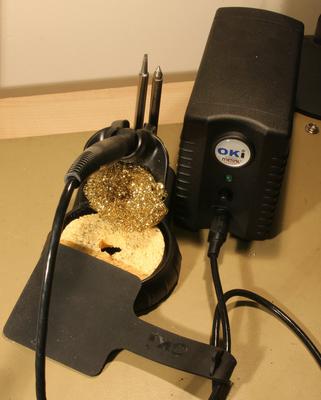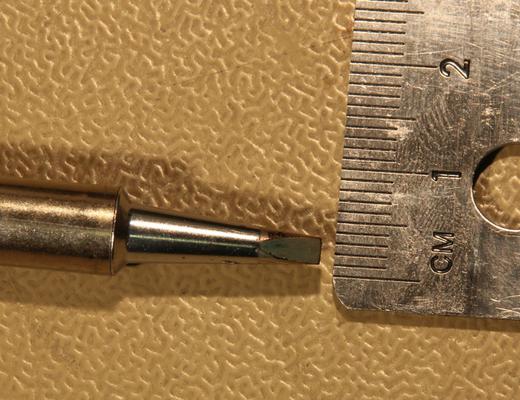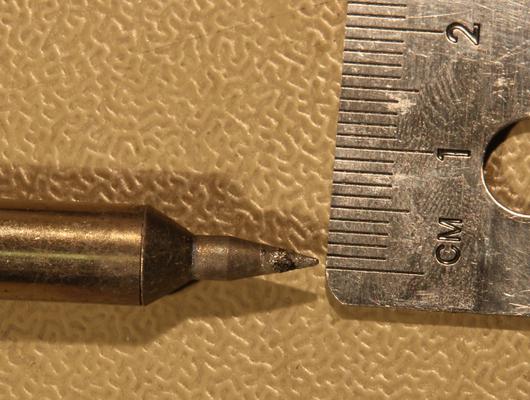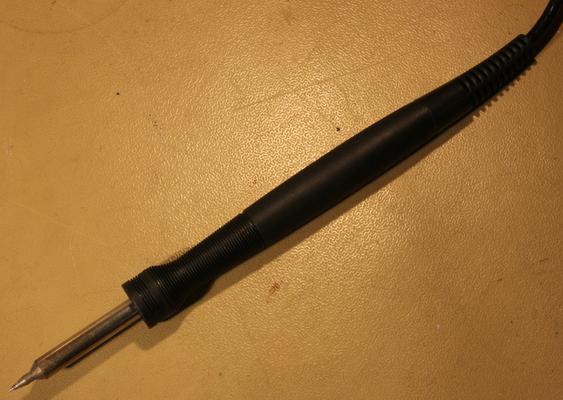OKI Metcal PS-900 Soldering Iron Review
Last updated: Aug. 28, 2012, 1:41 p.m.
Having a really good soldering iron can really affect the range of parts you can use in projects and the time it takes you to do things. I've been using a Weller TCP iron that was originally owned by Tektronics for many years and it has been a great tool (and still is!) but upgrading this to lead free can be pricey and the temperature control in these old mechanical irons can make switching from soldering pads connected to hairline tracks to pads connected to ground planes a little dangerous for the components. I had a couple of bits of 0.5mm pitch soldering to do, so before I got started I decided to get a new lead-free compatible iron. After some research I settled on the OKI PS-900 soldering station.
Kit Contents (from Farnell UK, other suppliers may vary)
- Transformer/power-supply
- Handle
- Silicone pad for changing tips
- Heater element (plugs into handle and accepts tips)
- A broad chisel tip (about 2.5mm wide)
- Power saving stand (a magnet significantly reduces the temperature of the tip in the stand)
- Sponge and wire wool tip cleaner to fit stand
- Mains lead
At work I've used the Metcal SP200 soldering station, this was a very pleasant experience, the reliable temperature and fast power delivery from these RF induction irons is spectacular. Essentially the power supply is an RF power amplifier sending a signal depending on model between a few hundred kHz and a couple of MHz to the iron itself. The heater part (in the PS900 this is separate but in SP200 it's part of the tips) is an inductor specifically designed to consume the RF power put across it and get hot. The ferrite core is designed with a specific curie point which changes the characteristics of the inductor so it no longer consumes the RF power after a specific temperature. This is coupled with a very low mass tip so it has little thermal inertia so temperature control is very fast (no mechanical switching). This means that if you go from soldering one pin of a transistor which is connected to a signal trace which takes a tiny amount of power to heat to another pin which is directly connected to a power plane you won't have to wait long for the iron to heat up the second pin, and more importantly going the other way you won't over-heat the signal pin.
The other advantage to this type of iron is that the tips can be changed very quickly in production as there is no bolt to undo. The PS900 comes with a silicone pad on the cable which you can use to pull the tip off the iron and swap it for another one without waiting for them to cool down.
I've used the iron so far for assembling PCBs, working on strip board, splicing cables and soldering connectors to trailing leads and it's coped with all these jobs with ease. The greatest challenge I've attempted with it so far has been hand soldering 0.5mm pitch LQFP chips onto plain PCBs. I used some liquid flux and a 0.4mm tip and it took less than 10 minutes to do a 48pin chip with no shorts or dry joints, the soldering has been thoroughly inspected and tested functionally and it's working great. Having tried to do 0.5mm pitch soldering with the old Weller with a fine tip I can really recommend the iron as it made all the difference.
This is a fairly pricey iron at £166.80 inc. VAT, but if you want to work with modern surface mount parts this is probably a cheaper and more versatile route than a decent toaster oven setup. It also seems to be cheaper than most of the options for buying second hand soldering stations like the SP200 from eBay (not saying you can't find a bargain, but there weren't any when I needed an iron). I'd recommend this iron over anything from Weller or Antex in the same price bracket.
The tips are quite reasonably priced, the 0.4mm tip I bought is only £6.96 inc. Vat from Farnell which is one fear I had about this kind of iron, I was expecting to pay a lot for tips with the more advanced design (i.e. they're not just a lump of copper like old fashioned irons). The stand that comes with it has a big magnet in it as well, this affects the way the heater consumes power so that when the iron is put in the stand it cools down significantly, this reduces power consumption and prolongs the life of your tips. Thanks to the low thermal mass of the tip though it heats up almost instantly when you pick up the iron to start work.
Selling Points
- A great tool for all kinds of soldering
- Excellent power control
- Good selection of tips available
- Very fast heat up time
- Cheaper alternative to the "professional" SP200 and similar
- Light weight handle that doesn't get hot after prolonged use
Comments
Posting comments is not currently possible. If you want to discuss this article you can reach me on twitter or via email.



